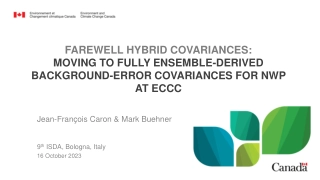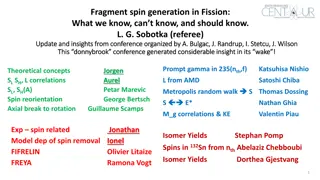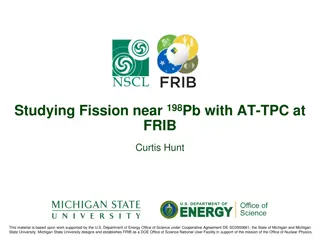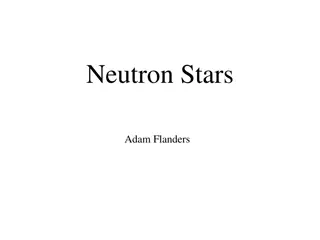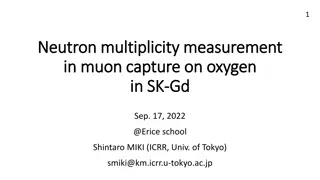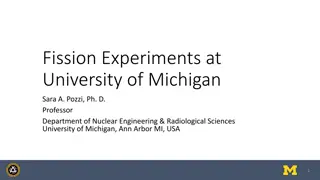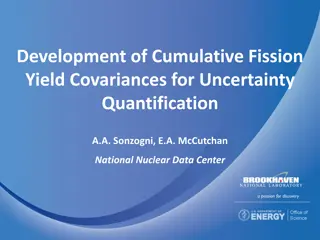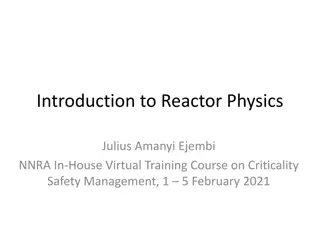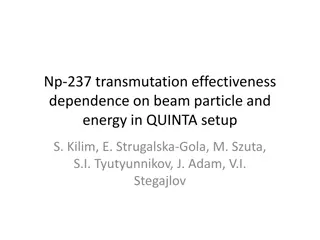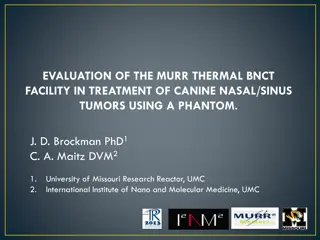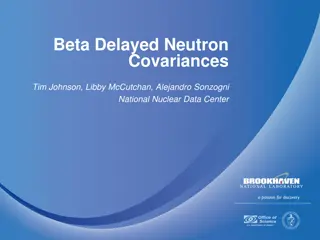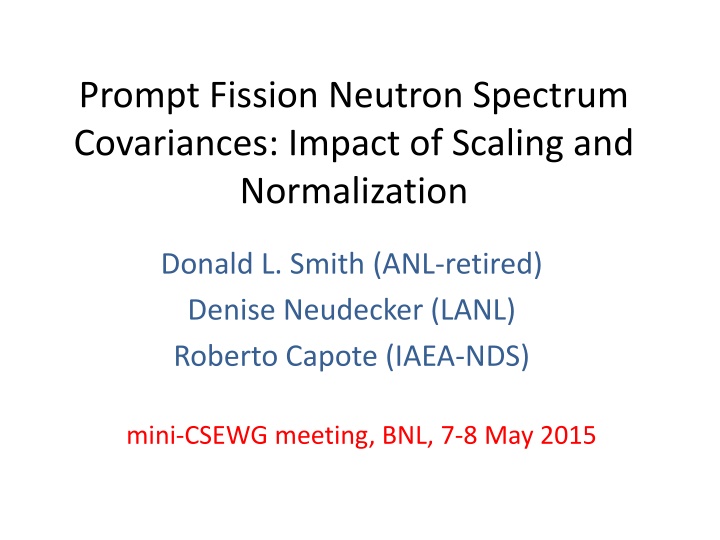
Prompt Fission Neutron Spectrum Covariances: Scaling vs. Normalization Impact
Explore the differences between scaling and normalization in evaluating Prompt Fission Neutron Spectra (PFNS), their impact on covariance matrices, and the nuances in handling experimental data for PFNS compared to cross sections.
Uploaded on | 0 Views
Download Presentation

Please find below an Image/Link to download the presentation.
The content on the website is provided AS IS for your information and personal use only. It may not be sold, licensed, or shared on other websites without obtaining consent from the author. If you encounter any issues during the download, it is possible that the publisher has removed the file from their server.
You are allowed to download the files provided on this website for personal or commercial use, subject to the condition that they are used lawfully. All files are the property of their respective owners.
The content on the website is provided AS IS for your information and personal use only. It may not be sold, licensed, or shared on other websites without obtaining consent from the author.
E N D
Presentation Transcript
Prompt Fission Neutron Spectrum Covariances: Impact of Scaling and Normalization Donald L. Smith (ANL-retired) Denise Neudecker (LANL) Roberto Capote (IAEA-NDS) mini-CSEWG meeting, BNL, 7-8 May 2015
Representation of Prompt Fission Neutrons in Evaluated Data Libraries Prompt neutron yield per fission is represented for applications in the following manner (e.g., in the ENDF-6 formats*): Y(Eni,Eno) = (Eni) (Eni,Eno) 0,Em (Eni,Eno) dEno = 1 (for all Eni) Eni = incident neutron energy; Eno = outgoing fission neutron energy. (Eni,Eno) 0 for all Eno > Em (Em 20 MeV**). (Eni) and (Eni,Eno) appear in separate evaluated data files. (Eni) and (Eni,Eno) are usually measured using quite different experimental techniques. (Eni) is usually known to considerably better accuracy than (Eni,Eno). (Eni,Eno) is referred to as a prompt fission neutron spectrum or, for short, a PFNS. It is effectively a probability distribution (PDF). (Eni) is known as nu-bar., i.e., total number of prompt neutrons per fission. *ENDF-6 Formats Manual, ed. M. Herman and A. Trkov, Report BNL-90365-2009, Rev.1 (2010). ** For the major actinides (i.e., 235,238U and 239Pu) nu-bar and PFNS are given in ENDF/B to 30 MeV, depending on the fissionable isotope. For most applications, 20 MeV is a practical upper limit of emitted neutron energy.
It would appear at first glance that the procedures for evaluating PFNS and cross sections should be essentially the same: Assemble the experimental data. Adjust these data as needed. Eliminate poor quality or otherwise questionable values. Include a model to fill regions poorly represented by experimental data. Employ least-squares methods. Indeed, there are many similarities, but there are certain differences that have important implications for applications, especially as related to the covariance matrices for the evaluated PFNS as opposed to those for cross sections. These differences stem mainly from: Scaling. Normalization.
Scaling? Normalization? What is the Difference? These two terms tend to be used interchangeably in the literature --- this can lead to confusion for PFNS. In the case of PFNS, normalization is a particular type of scaling --- there is no change in the shape of a spectrum whether it is scaled or normalized . But, there are profound differences in the covariance matrices for scaled and normalized PFNS. This talk discusses the differences and their impact.
Concept of Scaling 10 10 1 1 Relative Neutron Yield Relative Neutron Yield 0.1 0.1 c_red = 1.489 c_blue = 0.753 0.01 0.01 0 2 4 6 8 10 12 0 2 4 6 8 10 12 Neutron Energy (MeV) Neutron Energy (MeV) For a proper evaluation, the input data must be comparable (no apples vs. bananas). Differences in otherwise comparable measured PFNS SHAPE values arise mainly from different fission fragment and/or neutron detection efficiencies in the experimental setups. Scaled PFNS are PFNS shapes such that each value in a particular set is multiplied by the same constant so that the ensemble of included data sets can be treated as comparable . Otherwise, too large chi-square values will be generated in least-squares evaluations. There is no unique way to scale PFNS. Optimal scaling minimizes the solution chi-square. The scaling process is relative absolute values of the scaled PFNS are not needed.
Scaling Procedures and Characteristics Scaling equations (in an energy-group formulation): ki = ck ki (k=1,K; i=1,n) Cov( k) = (ck x ck) Cov( k) k is the unscaled PFNS and k is the scaled PFNS. Cov( k) is the unscaled covariance matrix and Cov( k) is the scaled covariance matrix. Scaling preserves PFNS shape AND the correlation pattern of the covariance matrix. Before After No change!!
Normalization Procedures and Characteristics scaled --- but not normalized G = available i = arbitrary (collection of available scaled group values for a PFNS ). normalized all i = 1 (summing every group from zero to an upper energy Em should yield unity). Any PFNS can be scaled (that s obvious). Since a normalized PFNS is a PDF, the present interpretation of normalization to unity requires that the representation of a spectrum being normalized should span the entire energy range (0,Em) where the PFNS values contribute significantly to the energy integral of that spectrum. Most experimental PFNS cannot be directly normalized because of their limited energy-range coverage. However, in some instances adequate extrapolations based on models, systematics, or other information can be introduced to enable a largely experimental PFNS to be normalized. Most model-generated PFNS are inherently normalized. The relationship between a non-normalized and a normalized PFNS is NON-LINEAR. The matrix transformation from non-normalized Cov( ) to normalized Cov( ), as shown here, is linear. Covariance Normalization Procedure for Group PFNS: Cov( ) = Q x Cov( ) x Qtranspose Qij = (G* ij - i)/G^2 ij = = 1 if i=j and = 0 otherwise. The rows and columns of cov( ) should sum to exactly zero (to within numerical precision of the computational procedure).
The M-B function is an extreme case that demonstrates how normalization affects the errors and correlation matrices for a spectrum shape. Maxwell-Boltzmann (M-B) Distribution Unnormalized Formalism Normalized Formalism f = f(E) = C * sqrt(E) * exp(-E/T) Cn = [2/Sqrt(pi)]*[T^(-3/2)] df = (df/dT) * dT (T > 0; C = constant) fn = fn(E) = Cn * sqrt(E) * exp(-E/T) (df/dT) = C * sqrt(E) * exp(-E/T) * (E/T/T) (dfn/fn) = abs[(E/T) - (3/2)]*(DT/T) f(E) is non-normalized fn(E) is normalized (df/f) = (E/T) * (dT/T) Pivot Point ===> (E/T) - (3/2) = 0 dT/T = 0.05 Red correlations = +1 Blue correlations = -1
18% 30% z The 3 spectra are scaled. is the solution. The errors are shown. 16% % Unc i 25% 14% % Unc Ni 12% 20% 10% 15% Compares the non- normalized and normalized errors. 8% 6% 10% % Unc z0i 4% % Unc z1i 5% 2% % Unc z2i 0% 0% % Unc i 0 5 10 15 0 5 10 15 Neutron Energy (MeV) Neutron Energy (MeV) Non-normalized Solution ( ) Normalized Solution ( ) Normalization: Reduces error overall, and it also changes the covariance matrix correlation pattern.
This more detailed example illustrates the various uncertainty components for the normalized PFNS: Statistical, scaling, and normalization: The scaling uncertainties (100% correlated across all PFNS data points) are completely eliminated upon normalization of a PFNS. The strongly correlated uncertainties (typical of model-calculated PFNS) are reduced by normalization. Unfortunately, it is difficult to conjure PFNS models that do not have relatively strong correlations (few parameters). So, inclusion of model PFNS data can lead to evaluated PFNS with too small errors. Notice the dramatic difference in correlation patterns!!
Key Points and Some References Collections of PFNS need to be scaled so as to be comparable prior to their evaluation. Scaling is a relative process and not an absolute one. PFNS scaling does not affect the covariance matrix correlations. Optimal scaling leads to the minimal chi-square possible for the evaluated solution. Complete PFNS that span the whole spectrum energy range can be normalized. PFNS normalization to unity (a probability distribution) is a non-linear process. Normalization does not change the PFNS shape but it has a dramatic effect on the properties of the covariance matrix. Scaling uncertainties (100% correlated across all PFNS data points) vanish when the spectrum is normalized. Model PFNS tend to be inherently normalized (e.g., the Los Alamos Model). The strong correlations of models tend to lead to unrealistically small evaluated PFNS uncertainties, especially near the pivot point , when the spectrum is normalized. It is generally best to evaluate non-normalized (scaled) PFNS and then normalize the evaluated solution afterwards, as required to satisfy ENDF-6 format requirements. However, mixed non-normalized and normalized PFNS can be evaluated if properly scaled. The expected minimal uncertainty (pivot point) for an evaluated PFNS should be defined by the experimental shape uncertainty, i.e., the uncertainty AFTER normalization ( 1%). *D. Neudecker et al., Impact of the Normalization Condition and Model Information on Evaluated Prompt Fission Neutron Spectra and Associated Uncertainties, to be published in NSE (2015). *D. Neudecker et al., Evaluation of the 239Pu Prompt Fission Neutron Spectrum Induced by Neutrons of 500 keV and Associated Covariances, submitted to NIM-A for publication (2015). *D. Smith et al., Prompt Fission Neutron Spectrum Evaluation Techniques, Report INDC(NDS)-0678 (2015).

